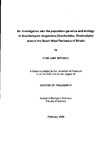An investigation into the population genetics and ecology of Gracilariopsis longissima (Gracilariales, Rhodophyta) around the South West Peninsula of Britain
| dc.contributor.author | MITCHELL, TEAN JANE | |
| dc.contributor.other | School of Biological and Marine Sciences | en_US |
| dc.date.accessioned | 2013-11-19T11:54:52Z | |
| dc.date.available | 2013-11-19T11:54:52Z | |
| dc.date.issued | 2008 | |
| dc.identifier | NOT AVAILABLE | en_US |
| dc.identifier.uri | http://hdl.handle.net/10026.1/2770 | |
| dc.description.abstract |
For the conservation and management of natural resources, a detailed knowledge of the ecology and genetics of individual species is essential. Red seaweeds are an important component of marine ecosystems but few species have been the focus of research. Gracilariopsis longissima is a poorly studied member of a family of agarophytes of commercial importance, although it is thought to occur commonly around the coast of Britain. This report provides new information about the ecology and population genetics of the species with the identification of 11 populations around the coasts of Devon and Cornwall, seven of which were in the Fal Estuary and Helford River complex. Site characteristics are described, in particular with regard to substrata which were found to be significantly different between sites. New ecological data about algal assemblages in which Gs. longissima occurs is reported for spring (four sites) and summer (five sites), with significant differences seen for all except two sites. Anecdotal reports that Gs. longissima grows mainly on smaller substrata were investigated but were unsupported by the evidence, although a non-random distribution with respect to substrate size was found, which needs further investigation. Microsatellites were newly developed for the species but were thought to be monomorphic and were not pursued. Cross-genera amplification with Gracilaria gracilis microsatellites did not provide sufficiently reliable data. A number of molecular methods were optimised and used to identify populations and investigate the genetics of three populations. These results are the first report of population genetics in the species. Intra-population genetic variation was seen to be high when estimated using RAPD primers and was accompanied by significant differentiation between the populations investigated. Biofilms occur on almost all submerged aquatic surfaces, including living organisms. Gs. longissima is no exception: epiphytes and biofilms were investigated and found to be highly diverse and well-attached, with some thalli in some populations completely obscured by overgrowth. Cleaning methods were tested, with mechanical removal proving to be the most successful. Biofilms were also found to affect RAPD profiles, confirming that cleaning of wild collected specimens was essential for reliable RAPD data to be obtained. | en_US |
| dc.language.iso | en | en_US |
| dc.publisher | University of Plymouth | en_US |
| dc.title | An investigation into the population genetics and ecology of Gracilariopsis longissima (Gracilariales, Rhodophyta) around the South West Peninsula of Britain | en_US |
| dc.type | Thesis | |
| plymouth.version | Full version | en_US |
| dc.identifier.doi | http://dx.doi.org/10.24382/3574 |
Files in this item
This item appears in the following Collection(s)
-
01 Research Theses Main Collection
Research Theses Main


